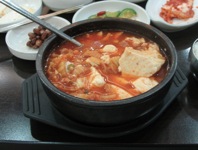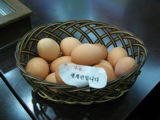We have three different teachers teaching my class Korean each week and each have their designated days. With the right encouragement, one of my teachers loves to tell us stories about her stormy university life in the 1980s and make observations about Korean society. From a strict pedagogical standpoint one might make objections to her use of class time but I find her anecdotes incredibly entertaining and educational. Her approach is in stark contrast to one of my other teachers who is so concerned about bringing up controversial issues that discussion of “politics and anything about Korea” is banned in class presentations.
This week, my favorite teacher told us a few stories about student protest life and threw in a few stereotypes of some of the universities here. She never said anything about her own involvement and always described things in the third person but the level of detail gave me the impression of her having been quite active.
She described how students emerge from high school with little or no political consciousness. When they enter university and join social or athletic “circles” they soon find themselves reading Marx and “socialist” texts. She said that even students who wanted to study hard and stay out of the political activities would be under heavy pressure to get involved or be seen as socially irresponsible.
She talked nostalgically about the days when the SNU campus was patrolled by fully armed riot police. She described how student leaders would write the location and time for large protests on their hands then, as they passed other students on campus they would quickly show the palm of their hand to the student and then hide it again, wiping the ink off their hands if apprehended by the authorities. She said this kind of thing made [them/her?] feel like spies. When the students assembled in a public place, she claimed, they would pretend to just be roaming about or shopping. Then, at the appropriate signal, usually a first attack against the police or other target, the students would all rush forward. She said there was also often a kind of gender division in which women would break up larger stones into an appropriate size for the men to carry to the “front lines.” As she told these stories, I was particularly curious what might have been going through the minds of the Chinese students in the class. Where they shocked and horrified? Secretly filled with admiration? Or completely apathetic and detached? I just couldn’t tell.
She talked about some of the stereotypes of various schools she had heard. First, on the character of their males as judged by their dating behavior: Seoul National University: “If during the date the woman says, ‘I’m cold!’ The man would warm himself and say, ‘Me too!'” Yonsei: The man would give the woman his coat. Koryeo: The man would respond, “Why don’t you run around a bit to warm up?”
She then told us a bit about her stereotypes of the university student protesters based on ideology. Seoul National University: These students, the elitist cream of the crop in Korea she called “opportunistic socialists” who would all happily protest during their student years and then take government or corporate jobs when they emerged from university life. Yonsei: Non-committed “liberalists” Koryeo: Apparently is known for having many students from outside of Seoul and their protesters were apparently stereotyped as the most ideologically hard-line “Communists” Seongkyunkwan (I’m not 100% this was the university, but some university in Seoul starting with S and it wasn’t Sogang, it had more syllables): She said something about the campus of this university being really small and cramped and that the protests here supposedly got really violent with the police in very close quarters. She said their student protesters were called 깡패 or something, which in my dictionary is defined as a hooligan, a gangster, or a ruffian. Incidently, the dictionary also lists 깡패국가 as the word for “a rogue state.”
If I could improve my Korean enough, I would love to try to get my teacher to agree to an interview or a kind of oral history of her memories from this time.

